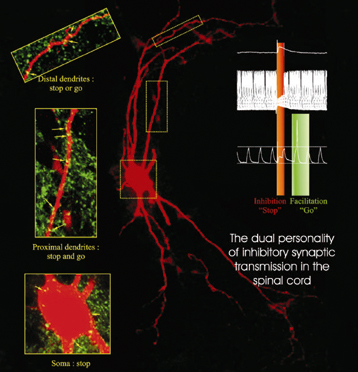
The above image comes from a CNRS press release about the “double personality” of inhibitor neurons. Oh, and yes, the press release is in French. Sorry ’bout that. CNRS maintains an English site as well, but it lags several weeks behind the French site (shocking, I know).
Basically, researchers have discovered a chemical basis for the function of inhibitor neurons—neurons that seem to play a role in disorders such as paralysis and epilepsy. According to the new findings, the firing of a neuron (“stop” and “go,” as it’s described in the figure above) depends on the concentration of chloride ions, which is in turn controlled by proteins in the surface of the neuron.
To my eye, the visualization (presumably of actual data) communicates its message quite clearly. First off, it capitalizes on existing color associations with “stop” (red) and “go” (green), but it also does a nice job of highlighting specific regions of the neuron (n.b. “stop or go” and “stop or go”). A lot of information in a small space. The little diagram on the upper left is far too small for me to make out, but I’m guessing that it contains information that I would find interesting were I able to read it.
The red-green color scheme also seems to correlate with the use of bioluminescent tags in various samples. The book Aglow in the Dark: The Revolutionary Science of Biofluorescence taught me a wee bit about this field. Fascinating stuff.



